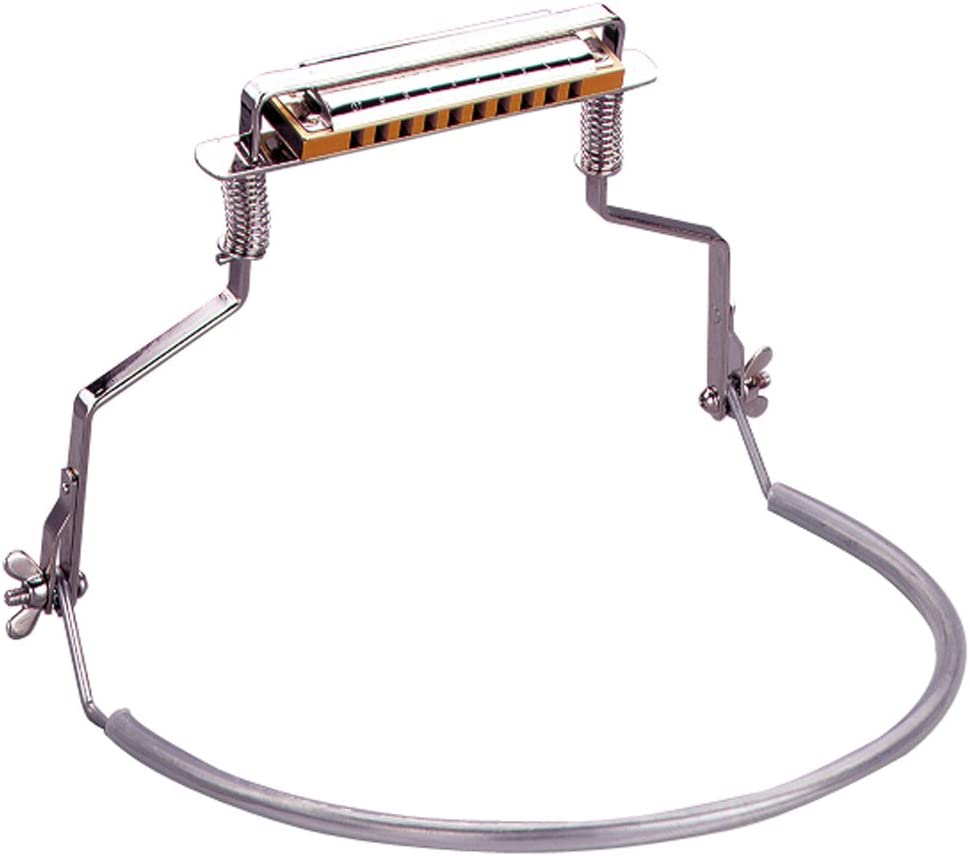Hands Free Chromatic Reviews

Products with electrical plugs are designed for use in the US.
Hands Free Chromatic Review
The diatonic harmonica is one of a very select group of musical instruments that can be played without the use of the hands; all you need is some way of holding the harmonica to your mouth and your hands are free to play another instrument. The sight of the singer guitarist with his 10-hole diatonic in a neck rack is a very familiar one, but things are not quite so simple with the typical chromatic harmonica, all because of that pesky button.
Of course, you could put your chromatic in a rack and simply restrict yourself to tunes that require no sharps or flats, but if you are going to do that, you would probably be better off simply using a diatonic. Not surprisingly, there have been several attempts over the years to provide a way of getting the sharps and flats whilst leaving the hands free, most of them using a foot operated switch connected either mechanically or electrically to the button on the harmonica. Equally unsurprisingly, these devices have generally been noisy, clumsy or both. Finally, someone has come up with a nice simple solution which is quiet and efficient and also has some unexpected beneficial side effects.

Vern Smith is a familiar name to anyone subscribed to the various online harmonica discussion groups such as harp-l and Slidemeister. As someone who plays both guitar and chromatic harmonica and wanted to be able to do both at the same time, Vern has put a lot of thought into the problem and his remedy is the Hands Free Chromatic (HFC). The HFC replaces the standard slide assembly with a one-piece plastic mouthpiece held in position by a spring at each end. In its normal position, the mouthpiece allows the natural scale to be played; to play the sharps and flats, all that is required is a slight nod of the head.
It sounds like this might be an awkward technique, but after having played the HFC for a while I was amazed at how quickly it began to feel very natural indeed. According to Vern the angle required to shift from naturals to sharps/flats is about 1.5 degrees and it takes about 3oz (85g) to push the HFC mouthpiece, compared with about 26oz (737g) to push a conventional slide button! With very little practice I found that I could play trills and chromatic phrases almost as easily as I can using the conventional push of the button.
With some real practice, I'm sure the HFC could do anything that can be done with the standard chromatic harmonica. At the SPAH convention last year, jazz harmonicist (and no mean jazz guitarist) William Gallison blew everyone away with some dynamite playing on the HFC accompanied by his own guitar, within minutes of first seeing the instrument. At the same event, Douglas Tate also had the opportunity to try it out and had this to say:
"Vern Smith, my long time friend and adversary... What an amazing instrument he has come up with. I was privileged to be allowed to play his new "Hands off, You Don't Need a Button, Just a Mobile Head" harmonica. Vern's HFC harmonica is beautiful... it works, is natural to play. I spent a happy few minutes playing duets with him on it... I would say that the average player who is used to the idea of playing sharps and flats would take a couple of minutes to suss it out and about half an hour to become so used to it that you could forget the technique. Vern's claims about the airtightness of the instrument are absolutely correct, it is tight."
This airtightness is the unexpected benefit I mentioned earlier. As you probably know, the standard chromatic harmonica is a rather inefficient machine. Much of the air that should be going through the reeds ends up escaping via several places, the slide assembly being the worst offender. Tighten it up to prevent air loss and the slide doesn't move freely; loosen it to achieve an easy slide action and it starts to leak again.
A good technician can achieve a reasonable compromise, but the HFC sidesteps the problem completely. The mouthpiece is held loosely against the front of the comb, but as soon as you play the instrument it is pushed lightly but firmly into place, with no air leaks at all. For this reason alone, the HFC would be valuable to any chromatic player, even if they do not play a second instrument.
Not having to push the button is very liberating in other ways - both hands become freed up to work on tonal effects or cupping a microphone, without having to make sure that one hand is in the correct position for the button. I also found myself playing with the HFC in my left hand, as I typed one handed at my computer keyboard!
After working with the HFC for a short while, I was struggling to come up with anything negative to say about it. It looks like it may be quite flimsy, but it is surprisingly robust. If you were to drop it on a hard floor, you might damage it, but the same is true of any harmonica, or indeed any musical instrument. I can imagine some players will not like the plastic playing surface or the round holes in the mouthpiece, but as a fan of the CX-12 I am very comfortable with both. About the only other thing can I say is that it would be nice to see a 4-octave version.
So, get one of these and all you need is a good neck rack to support the HFC as you play - and Vern has that covered too!
Most neck racks currently available are rather flimsy affairs that look like they have been quickly cobbled together from an old coat hanger, many of them too small to hold a standard chromatic harmonica. Vern offers a heavy-duty, ergonomic harp holder that was designed with the HFC in mind, the catchall named Ergomonic Neck Rack (ENR).
The ENR was made as adjustable as possible, allowing the harmonica-to-mouth distance to be varied, the height of the harmonica to be raised and lowered and the angle of the harmonica to be adjusted relative to the player's head. Hopefully this will put an end to all those strange contortions people seem to have to do whilst playing simultaneous harmonica and guitar (or piano, or concertina, or Theremin, or whatever...).
Update
The manufacture of the Hands Free Chromatic and Ergonomic Neck Rack has now been taken over by Mike Easton and several improvements have been made to both of them since I wrote the above review.

